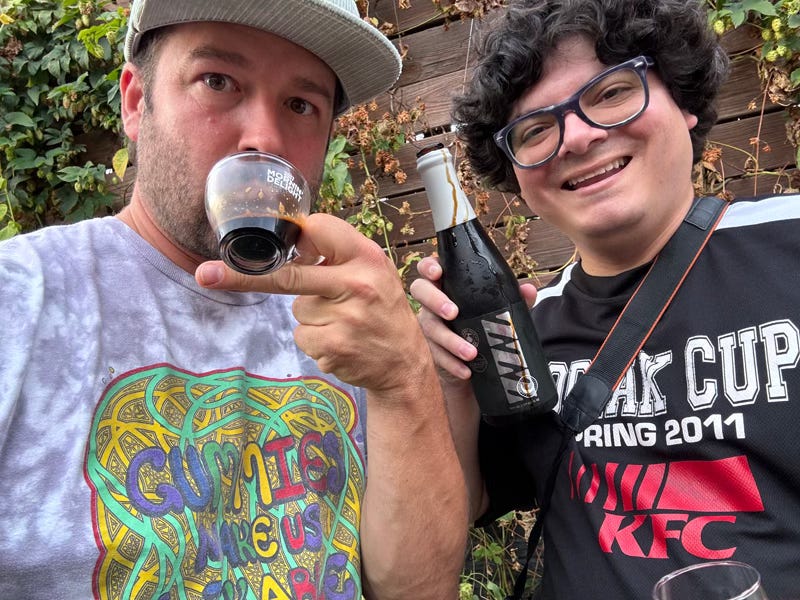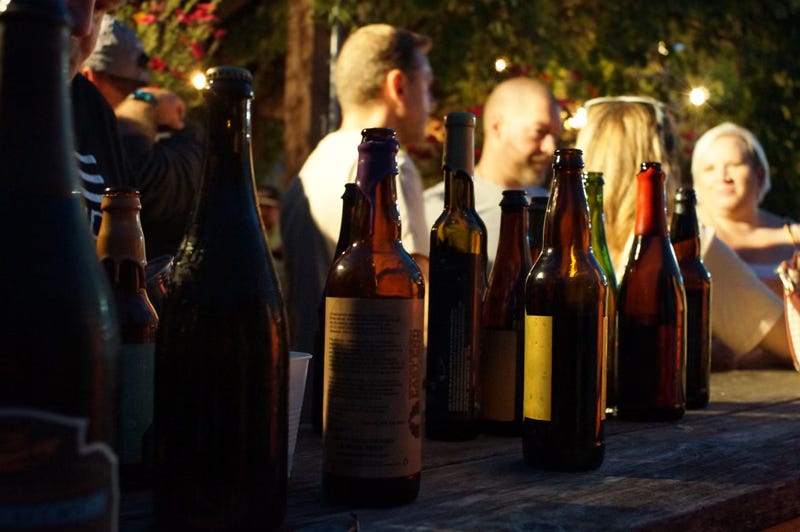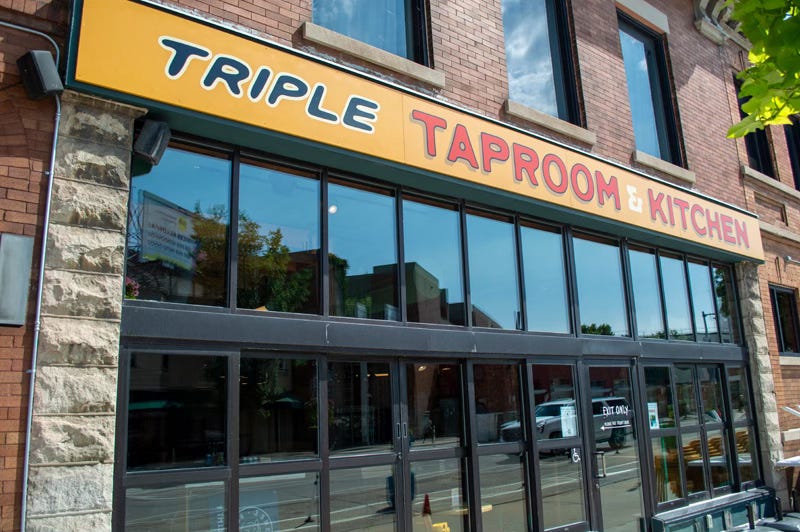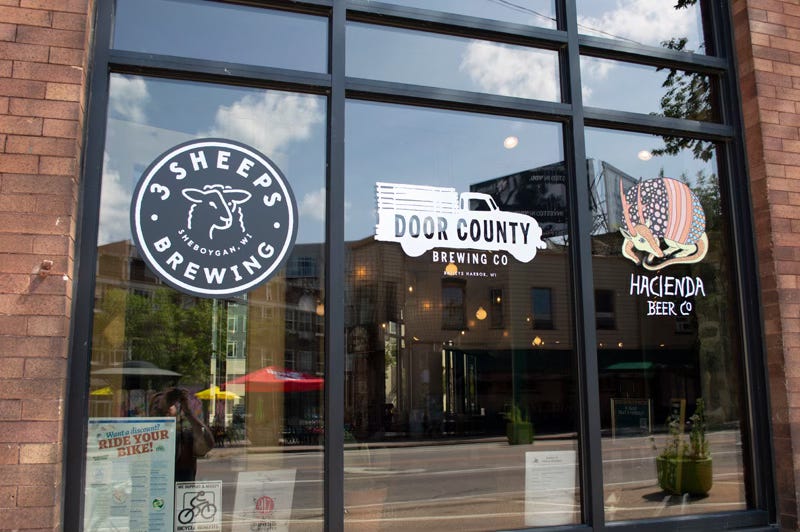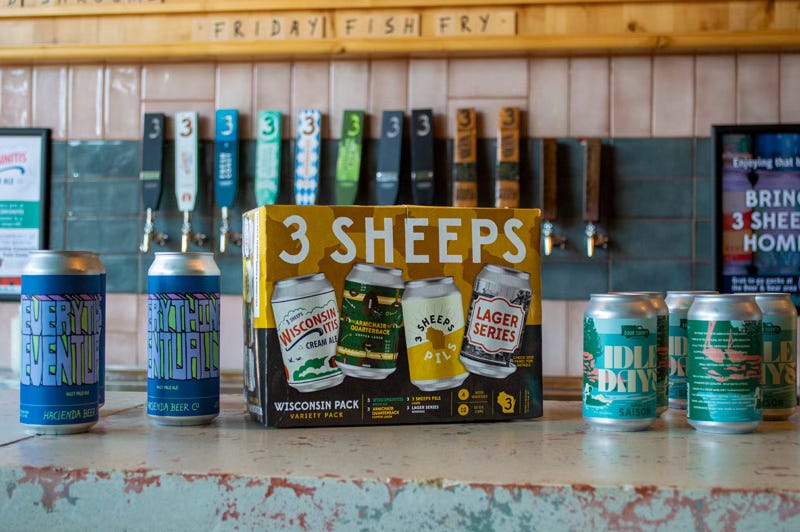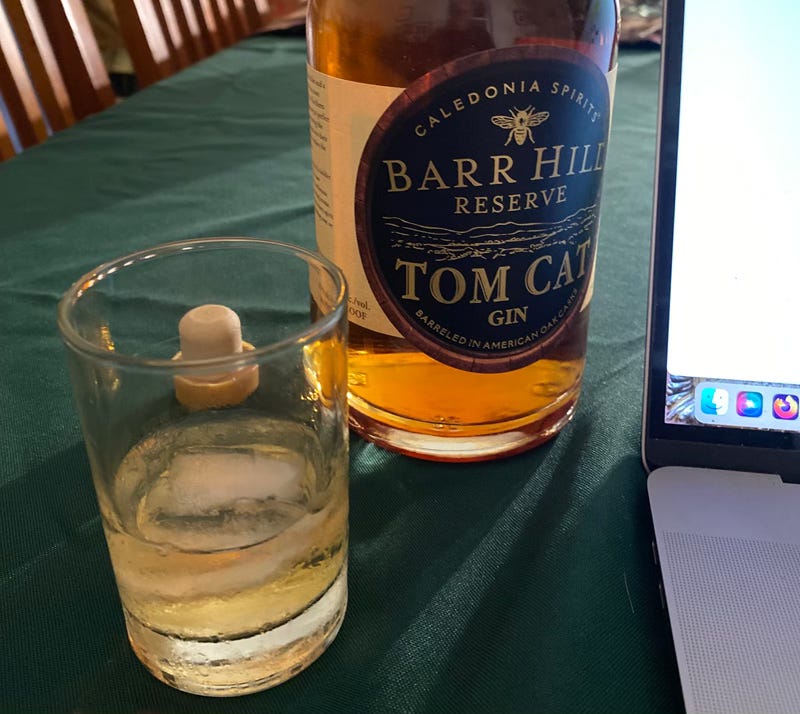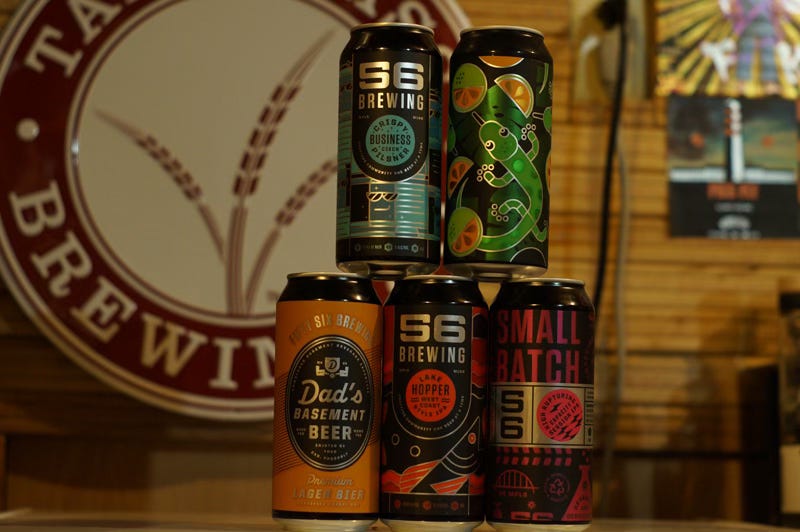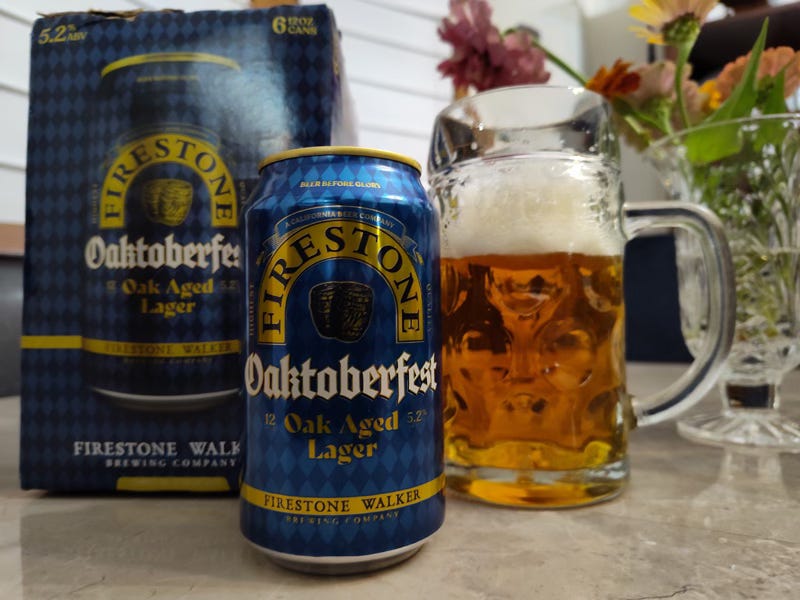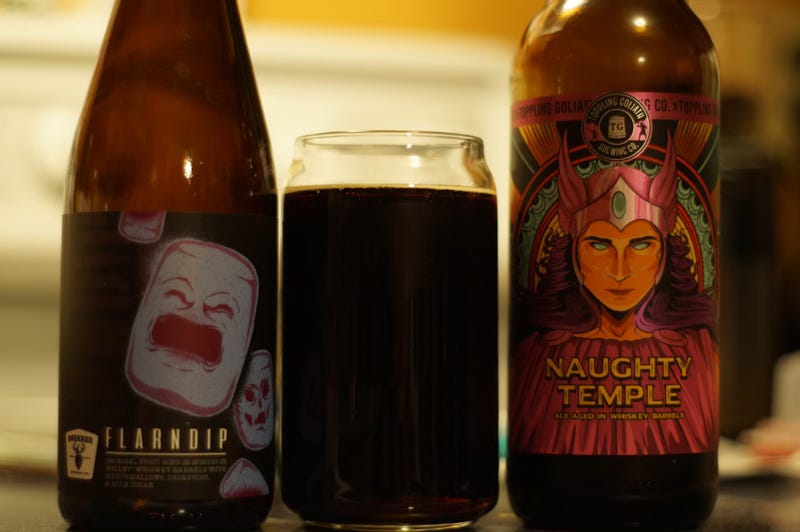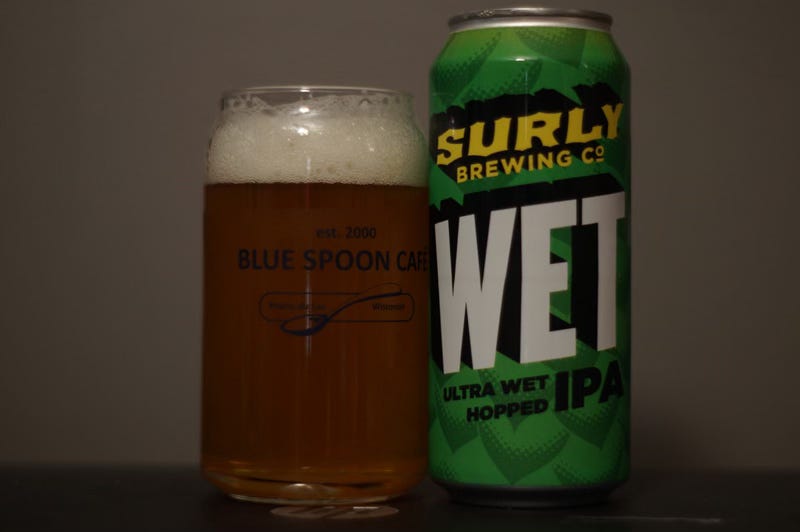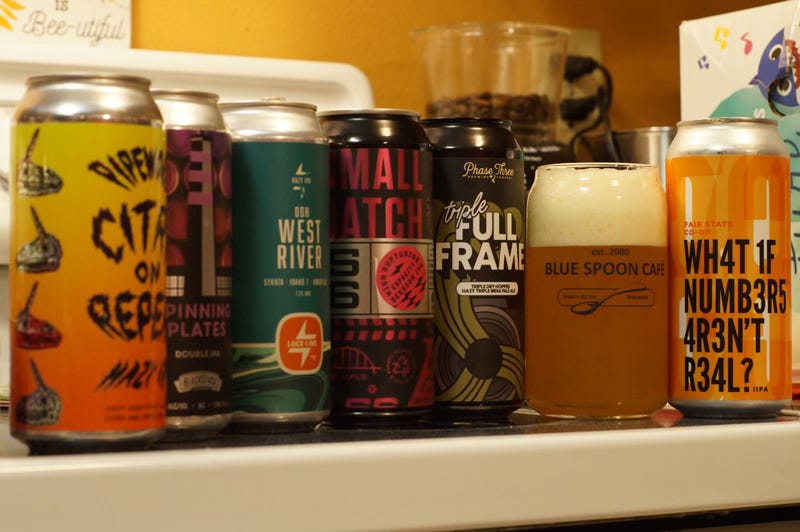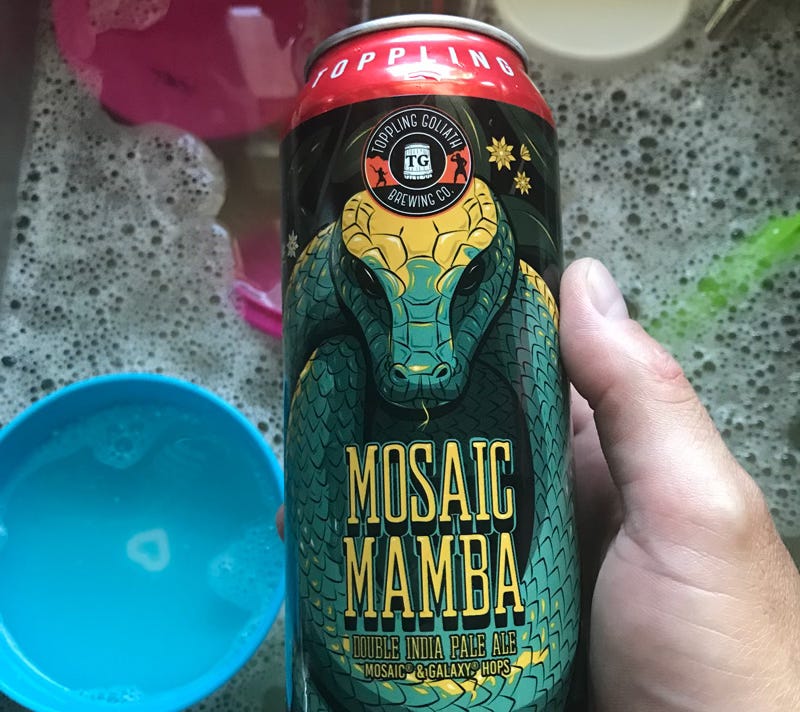This newsletter is written and edited by Louis Livingston-Garcia unless otherwise noted, and is available in full to all of Heavy Table’s $5/month Substack and Patreon subscribers.
I was in Rochester for a Forager member party (above right), and, as always, it was fantastic.
Of course there was the rare, fantastic beer. Many of them were mine. I brought some recent Phase Three barrel-aged stouts, but the rarest of all was a barrel-aged stout Forager collaborated on with Weldwerks. Even Austin Jevne (above left), former head brewer of Forager and now unpaid consultant, hadn’t had it due to his keg being accidentally poured in Colorado.
It was a vanilla bomb (they added way more vanilla than Jevne would), but still fun to share as everyone was so excited to see something they hadn’t even heard of. But the rare beers aren’t what makes these so special.
In my youth, gatherings were anchored by video games and soccer. Now friends are brought together by beer or good food. So many hugs were had. Goodness, the event was so amazing. It is a reminder of how little I see my Rochester friends these days.
But to have days like this make up for it. Find a group to share beer with, or food – something, if you haven’t. But I recommend beer. It’s such a fun thing to open and share with others. And the alcohol helps people loosen up and become quick friends.
UNDER ONE ROOF
Shared taprooms represent a new form of inter-brewery collaboration.
By Loren Green
The beer scene is like any other industry. There has been much discussion about breweries closing – nationally and locally – and beer sales and hype aren’t what they were in the pre-COVID so-called “craft beer boom.” The simple fact is that change is inevitable. August Schell Brewing Co. and Minhas Craft Brewery are hardly the same businesses they were when they opened their doors in 1860 and 1845, respectively. Adaptation is the key to survival.
In July FINNEGANS Brew Co. announced that they were closing their Irish pub-themed taproom in the Elliot Park neighborhood of Minneapolis. But the closure isn’t the end of the brewery, rather a shifting focus. On October 4, FINNEGANS moved into the Fulton taproom in the North Loop neighborhood. Branded as a residency, it’s essentially a contract brewing scenario that adds another layer to an existing taproom in the heart of the city.
Meanwhile, across the St. Croix River and nearly 400 miles east on I-94, 3 Sheeps Brewing, Door County Brewing, and Hacienda Beer Co. have opened another shared space in Milwaukee that they call the Triple Taproom & Kitchen.
A STORY OF CREATIVE ENTERPRISE
FINNEGANS has always been a brewery that does things their own way. Jacquie Berglund formed the company back in 2000, initially contract brewing at James Page and then at Summit, distributing kegs and bottles in a pre-taproom era. The brewery struck out on their own, opening the Elliot Park taproom on Saint Patrick’s Day weekend 2018, expanding their beer lineup and business model in the process. Besides making beer, FINNEGANS’ mission has always been to give back to the community, with a Community Fund that reinvests their profits to feed the hungry.
Pandemic lockdowns cut into business and, as Berglund puts it: “We were increasingly aware that we needed to streamline our operations and shed expensive overhead.” Taprooms require service staff, longer hours, and more licensure and liability insurance. In a nutshell, the residency system allows FINNEGANS beers to be brewed and sold on draft by Fulton employees. FINNEGANS maintains brand awareness while farming out the service-side of the business. “The residency is unequivocally not an acquisition,” Berglund stresses. FINNEGANS current ownership controls the company’s future, while their taproom employees have been given opportunity to apply for jobs at Fulton. After the transition is complete, FINNEGANS management can focus on the business end of making and selling beer (and the Community Fund).
The big question for FINNEGANS fans is: “How will this work?” Flagships such as Irish Amber Ale, Blood Orange Pilsner, and Dead Irish Poet Stout will be on tap at Fulton, and Fulton’s taproom has added some of the same pub-style furniture that previously decorated the Elliot Park location. You’ll see FINNEGANS signs, and the FINNEGANS “reverse food truck,” parked near the Fulton’s house food truck restaurant. It will be a multi-themed mash-up where you can imbibe in Fulton’s garage aesthetic and also the cozier confines of the Irish pub.
“You just don’t see many other Minnesota breweries taking advantage of [contract brewing] right now and we’re embracing it,” Berglund summarizes. “This concept of breweries working together – that a rising tide raises all ships – has always been critical to the growth of the craft beer industry.”
“In order to continue to see smaller breweries thrive, it takes getting creative,” she says. FINNEGANS is getting attention for the collaboration right now, but Fulton is also embracing the change. Fulton is nearing its fifteenth anniversary, and the two companies had a well-developed relationship that spawned the new residency.
“FINNEGANS will remain the same classic Irish community-minded beer brand that will continue to turn beer into food. We will just have a fun new partner to blaze a new trail with and everybody wins,” Berglund says.
A THREE-IN-ONE TAPROOM IN BEER CITY
Door County, Hacienda, and 3 Sheeps, teamed up to open a shared space taproom in East Side Milwaukee in mid-July. It features familiar taproom elements: rustic meets industrial meets modern, with a layout to highlight the different brands served. Like the Fulton/FINNEGANS collaboration, it is owned and operated by a single brewery, Door County. Hacienda is an offshoot of Door County, while 3 Sheeps is a separate entity with their own large facility and taproom in Sheboygan.
Just like Fulton and FINNEGANS, the Wisconsin breweries had a strong relationship prior to taking this step. “We’ve worked with the team from Door County and Hacienda for about four years and have become good friends. They brew much of their beer at our facility, and one day we just joked that we did so much together we may as well share a taproom,” says Grant Pauly, founder and head brewer at 3 Sheeps. “About a month later, I was meeting with them and we broached the subject, only to realize that we had both been thinking about it since we joked about it.”
In other words, Door County/Hacienda was already contract brewing in Sheboygan. Then, in a sense, roles reversed in Milwaukee. “The Triple Taproom is 100% owned and operated by Door County Brewing,” Pauly says. “Their awesome staff runs the taproom and kitchen. We get to work with them so they can tell the stories and educate [the public] about our beer.” Given the contract brewing partnership, “We really get to partner and support each on every level of the brewery experience.”
At the Triple Taproom, the Door County and Hacienda brands are already somewhat intertwined. Meanwhile, “The layout of the Triple Taproom naturally creates a two-space feel, which has worked out well. The horseshoe-shaped bar is divided by a wall, with 12 taps on each side – one side dedicated to 3 Sheeps and the other to Door County/Hacienda. As the “guest,” 3 Sheeps incorporates their brand through design and decor elements. They also carryover programs from the Sheboygan taproom, such as “Charity of the Month” and bigger brewery events such as “Weekend of The Wolf,” an annual party for the release of barrel-aged imperial stout The Wolf.
A CHANGING BEER SCENE
Every state has unique alcohol laws. This inevitably complicates collaboration, but as Berglund said earlier, it also inspires creativity. Breweries in Wisconsin are allowed multiple taprooms and even guest-brewed beers, unlike Minnesota, which allows one taproom and no guest beers with a standard brewery license. Even with different laws in each state, the breweries are making it work.
Removing overhead was a key inspiration at the Triple Taproom too. “We’ve all seen breweries see some success and expand too quickly, or to a point where they have trouble recovering with one or two small setbacks,” Pauly states when asked about taproom closures around the county, especially some high profile closures where breweries have expanded to new cities, such as Lagunitas in Chicago. On a smaller scale, one can point to the closure of Lupulin’s Sioux Falls taproom or Hop & Barrel in Spring Valley. “We want to be around a long time, and this was a very nice way for us to be able to get into the Milwaukee market and support a community that has supported us for 12 years, and also make sure we were doing so responsibly,” he says.
“As the industry changes and evolves, we have to evolve with it,” he adds. Innovation isn’t just a business buzzword, it has actual meaning. None of the breweries in this piece cited other taprooms that inspired their direction. For FINNEGANS, the concept grew from their continual networking, part of the brand since 2000. 3 Sheeps and Door County had an existing partnership already and the Wisconsin three decided it was time for another step. Rather than copying others in the beer world, Pauly specifically says that food halls and public markets were an inspiration. Ultimately, “All three brands make very different beer, so it just gave our customers a much wider range of choices and experiences.”
MYSTERY BOTTLE
Barr Hill Tomcat Gin
By John Fladd
Roger didn’t realize that he was in over his head, until it was far too late.
His wife had warned him.
“Where are you going?” she’d asked.
Marci Witherspoon asked if I could swing by,” he’d answered. “She texted me and asked if I could come over and answer a question for her. It shouldn’t take too long.”
“And you believed her?”
“Um… yeah?”
His wife had just stared silently at him. As the seconds ticked by, Roger realized that he was missing something, but – as happened far too frequently – he wasn’t sure what.
“Is there a problem?” he’d finally asked.
She pinned him with a steely gaze, and spoke slowly and deliberately – the way she did when she wanted to make certain that he or one of the kids were listening. “Whatever you do,” she said, ice water dripping from every syllable, “do NOT promise her anything.”
“I think it will be fine,” he replied. “She’s a sweet old lady.”
“She’s treacherous.”
“Um…”
There was silence for another ten seconds or so, then Roger finished putting on his jacket, and kissed his wife goodbye. He started to say something, but she cut him off.
“Treacherous,” she repeated.
There was another extended silence, then, not knowing what else to do, Roger turned around and left.
During the short drive to Marci Witherspoon’s house, he wondered briefly about whatever it was his wife had tried to tell him, then shrugging, put it out of his mind. One think he’d learned in fifteen years of marriage was to lean on his strengths; in his case, that was a sort of simple-minded optimism. Over the years, it had served him well.
It served him well as he knocked on Marci’s door. She answered it with a smile and a hug, and invited him into her dining room, where a little girl was sitting. She too, greeted Roger with a smile.
“Have you met my granddaughter Fern?” Marci asked?
“Hey, Fern,” he said.
“Hi,” the small girl replied cheerfully.
“Why don’t you have a seat?” Marci said, going to the sideboard and collecting a bottle and a couple of glasses. Roger sat down next to Fern, with a smile and nod of thanks to the girl, who grinned back at him.
Marci set the glasses and the bottle down on table, then took a seat. She poured a slug into her glass, then looked to Roger, with raised eyebrows.
“Just a tiny one,” he said, remembering his wife’s warning.
Marci poured a finger’s worth of gin into his glass, then raised her own in a toast. “I’m glad you could make it over today,” she said. “To your very good health.”
They each took a sip. Roger barely touched the gin to his lips, but after a moment, he raised his own eyebrows and finished it off. It was very good gin.
“What did you want to talk to me about?” he asked.
“Oh, just a couple of committee things,” she said, pulling a sheaf of papers out of a folder. She patted her neck, and the top of her head. “Oh,” she said, “I left my glasses over on the sideboard. Would you mind grabbing them?”
"Oh, of course not,” he said, getting up and fetching a pair of reading glasses. He returned to his seat, handed Marci the glasses, and finished off his fingerful of gin.
Marci went over some figures, and asked a few pertinent questions. “Ah,” she said after a moment. “Right here, what is this figure here?” She pointed to a number in a column on a spreadsheet.
Roger leaned over, and squinted to see which number she was pointing to. It took a second, but he finally located it. “Oh, that’s the accrued interest in the Building Fund account.”
“Oh, of course,” Marci said with a smile. “I lose track sometimes.”
“Totally understandable,” Roger said with a smile of his own, as he settled back in his chair, and finished his fingerful of gin. He was bothered briefly, because he thought he had already finished off his tiny drink, but Marci asked him another question, and he shook his head, and turned her attention back to her. They went over a few more figures.
This was clearly boring to Fern, and the little girl opened a sketch book and started drawing.
After a moment or two, she tapped Roger on his shoulder.
“Did I draw this flamingo’s legs right?” she asked. “I can never remember which way the knees bend.” Roger looked at the drawing, then a little closer.
“I don’t remember either,” he said, “but you’ve drawn each one bending a different way.”
Fern made a confused sound, and Roger bent over the sketch book to show her what he was talking about.
“Oh!” the girl said with an embarrassed smile, then energetically started to erase each knee on her flamingo.
Roger sat back in his chair again, and finished his tiny drink of gin. He paused for a moment, frowning with concentration, then shook his head and leaned on his strength of not thinking too much, and gave his attention back to Marci, who had another question.
It was only much, much later, that he realized with an aching head, that Marci and her granddaughter had taken turns distracting him, while the other poured a slug of gin into his glass, then distracted him again, before he could think too much about it. From time to time, he had asked himself whether he had just finished his drink a moment or two before, but after two or three times, his head got a little fuzzy, and he stopped caring too much.
To give Marci credit, she called an Uber to take Roger home, where his wife listened with a resigned sigh as he explained that somehow, he – and by extension, she – was in charge of the upcoming holiday bake sale, and that he was going to have to spend a the next couple of weekends, organizing the committee’s storage lockers, and searching for the props for a Vegas
Night fundraiser, which he also found himself somehow in charge of.
In the end, it wasn’t Marci’s treachery that impressed him – he had been warned, after all – but the masterful way that the little girl had blindsided him.
On the other hand, it had been very good gin.
Barr Hill Reserve Tom Cat Gin
750 ml
43% ABV (86 proof)
$54
There is a scene I love in the 1968 musical, Oliver, immediately following the hugely brilliant “You’ve Got to Pick a Pocket or Two” number, where the not-terribly-scrupulous mentor of child pickpockets Fagin, is trying to explain to young Oliver Twist about the comfort and safety that will be provided by joining his band of thieves.
“One of the child pickpockets interrupts him, complaining loudly, “These sausages are MOLDY!”
Fagin’s reaction is immediate and an inspiration to parents everywhere – “Shut up and drink your gin!”
When most of us think of gin – even if we are tremendously enthusiastic about it – it is usually in the context of a mixed drink. The idea of a Sipping Gin is a strange one. Sipping whiskeys, absolutely. Snifters of brandy, or rum, or even tequila? Please go ahead; life is short and you deserve a snort of the good stuff. But gin?
Tom Cat gin from Barr Hill is a sipping gin. It is made in small batches, with raw honey, and aged in oak barrels like bourbon. It smells of juniper and nutmeg (?) and caramel. Drunk neat or over ice, it is smooth and whiskey-like, with a faint but distinctly ginny aftertaste.
Normally, at this point, I’d give you instructions for making a clever cocktail with an equally clever name – A “World of Pure ImaGINation”, for instance – or with some intimidating preparation – fat-washing it with yak butter, perhaps – but while this gin improves any ingredients it comes in contact with, it is not itself improved. Go ahead and make a Negroni or an Old Fashioned with it – I have it on good authority that they will be delicious - but in the end,
you will probably find yourself sipping it neat or over ice.
A fingerful at a time.
THE TASTING ROOM
IN THE SPOTLIGHT
56 Brewing | Minneapolis
You may remember 56 for its racist incident years ago. I do too.
However, like my mentor and friend Dr. J Jackson-Beckham said during a keynote for the Craft Brewers Conference, sometimes we tend shame wrongdoers and not let them recover from a mistake. I’m paraphrasing, as Dr. J is a wonderful speaker, but the message was simple: in today’s world people like to shame and cancel and hate instead of find a way for those who make a mistake to grow.
We lack mercy.
J gave me that mercy back in my heart, and 56 has done a lot since that incident. It’s a wonderful brewery full of wonderful people, with one worker on the Minnesota Craft Brewers Guild’s Diversity Council (I am too).
I wrote a story on what 56 has done, linked above, since then, and I have since enjoyed the brewery. I’ve only been once after the State Fair opening day, but have had plenty of their beers recently thanks to a care package from the brewery.
Let’s break them down:
High Rupturing Capacity Session IPA. At 4.8 percent, this beer is more sessionable than some I see at five or six. And unlike those beers, this one matches New Zealand session IPAs with a bombastic, punchy guava and floral flavor. New Zealand session beers pack a lot of flavor in even lower ABV, but they have a drunk driving limit that is half of America’s, so they’ve figured it out out of necessity. This one matches many of those I had overseas, and it’s such a nice surprise. Plus, it uses experimental hop HRC-004, which is cool for many reasons.
A hop from the Hop Research Council, a non-profit funding and researching hops for the U.S., 56 is the first in Minnesota to use it. 56 brewer Zach Eicher said he noticed a lot of floral and herbal notes in the hop. It’s an interesting hop, especially in the day of hazies where everyone wants fruit flavors.
And if you haven’t noticed, the name of the beer matches the name of the hop, High Rupturing Capacity for HRC. But the name also comes from a random incident: lighting struck 56 a week before the beer was made. A transformer outside exploded. They lost temperature control. The transformers say, “caution, high rupturing capacity,” so it felt perfect.
Eicher actually grabbed the hops from former Minnesota hop grower and hop brand manager for Brewers Supply Group Eric Sannerud, who now runs a hop consulting business.
“It’s really cool working here because ownership … they're really into using those new hops, being the ones in the forefront of getting new, cool, and trendy things,” Eicher said.
With the eclectic mix of beers given to me, Eicher confirmed a thought I had: 56’s brewing philosophy is to have a variety of beers on tap. Recent release Honest to Goodness porter is a non-adjunct, regular porter. 10 years ago, that’s a normal sight. These days, you’re lucky to find a porter without marshmallow, coconut, or any number of adjuncts added. “It’s a regular ass porter,” Eicher said. 56 is bringing back a hazelnut brown ale, Hazelnut Brown, too. They even have a west coast IPA selling very well, which is a nod to yesteryear, which uses experimental hop WCHV-102.
“That’s another experimental hop that is going places,” Eicher said. “Give it a couple years and it’s going to be one of those hops that has a name. It’s a banging hop. It has grapefruit flavor, it’s piney, it has apple and pear notes.”
Eicher isn’t a brewer who came from homebrewing to brewing. Well, he did help his dad homebrew when he was younger, and he smelled many beers. In college he drank New Glarus Moon Man. He’s a trained environmental biologist, having worked at City Brewing in La Crosse, Wis. – home of the supersized six-pack – where he made more alcohol products in an eight-hour shift than 56 does in a year.
He also spent time at Surly, La Dona, and Pryes in Minneapolis. He’s a brewer who knows his way around.
The rest of the beers were also good.
Lake Hopper west coast IPA has a nice sweet, dank resin, propped up by orange marmalade.
Lizard Licker, kind of a smoothie, but more a heavily fruited sour, was a sweet mixture of mango and tart orange. I shared this one with a lot of people and each loved it.
Dad’s Basement Beer was approved by my father-in-law, Rick. If that isn’t enough of a good review – the man knows good lagers and Old Fashioneds – I’ll add my own assessment. Lightly toasted white bread crust, a touch of caramel, and just a really clean, proper lager.
Crispy Business, a Czech Pilsner, had a subtle spice to it on top of freshly baked bread. Another banger Rick also approved of.
They were all good beers. So good I am hoping 56 sends some of their new ones for review.
Eicher began as a teenager smelling his dad’s beer, and now he’s cranking out some great beers in a great space in a chill area. If you wrote 56 off before, check it out again.
And give it a good whiff as a nod to Eicher’s beginning
Oaktoberfest by Firestone Walker Brewing Company | Paso Robles, Calif.
Firestone Walker makes this beer every year, and it’s a nice way of putting an original twist on one of the few beer styles that seems like you can’t bog it down with a million “crafty” twists. This California brewed Märzen-style lager has all the traditional elements but just enough unique character from being aged on oak. It’s a very smooth lager, copper with a foamy white head, with the caramel notes you expect. It’s an almost creamy body, super smooth, with rich caramel balanced with earthy character, both from the hops and the oak, giving flavors of vanilla, leather, and wood tannins, plus a hint of caraway on the nose. It’s an “easy drinking” lager, but with a perfect blend of rich, sweet malt and more based oak character: an everyday beer with real depth. — Loren Green
Orange Creamsicle by Weldwerks Brewing Co. | Greeley, Colo.
Most of the time these pastry stouts taste similar or reminiscent to their namesake treat. This sour ale, though, is nearly a perfect match. It’s golden in color with a white head, which is maybe the biggest aesthetic difference. A little more orange hue would have paid off, because it’s a rich orange juice flavor with prominent vanilla that compliments but it doesn’t overpower. Many beers these days use vanilla for a lingering sweetness. Orange Creamsicle uses it for body instead. Then lactose gives a big cloying sweetness. This is a big fruit body with an equally big aftershock of sugar. It’s impressive in a sense, but I personally don’t want to drink 16 ounces of sorbet. Good execution in matching flavors, but this was too much by the end of the can. — Loren Green
Transmountain Diversion by Weldwerks Brewing Co. | Greeley, Colo.
Just like Orange Creamsicle, this is a big beer – but this one checks the “beer not dessert” boxes that keeps me coming back. A collaboration with Casey Brewing & Blending (also fro Colorado), this hazy double IPA highlights Nelson Sauvin and Citra hops and packs a big punch at 8.7% ABV. It’s thick and fizzy with an orange juice first impression, but with pineapple flavors taking the lead. You’ll also pick up on some sweet and subtle mango and guava underneath the big, bold acidic fruity flavors. While it’s big in every way, with a boozy note, it finishes soft on the tongue. Transmountain DIVERSION is a great example of what made this style so popular. It’s big and bold, but all of the flavors play together so well that it has real depth instead of being a one-trick pony. — Loren Green
PILS by Bang Brewing | St. Paul
I’m weirdly amused at this beer name. Bang always uses a four-letter format but it’s rarely this to-the-point. It’s perfect but somehow feels ironically uncreative for them. Anyway, this Bohemian-style Pilsner is floral and bready, smooth and refreshing. It’s fizzy, but with a super smooth body that’s pure bready goodness with herbal and floral notes, then a light lemon-orange note underneath. The body truly stands out: almost pillowy with a perfect foam head to complete the experience. It’s a very traditional beer but it’s big in flavor and, for the style, big in body too. While the floral and citrus brightness play well in warm weather, the body on this beer is a perfect and fulfilling fall and winter beer too. – Loren Green
Naughty Temple and Flarndip by Toppling Goliath and Drekker | Decorah, Iowa, and Fargo, ND
I’m an idiot. I told all of you I knew better than to buy a Drekker IPA. But sometimes, their barrel-aged beers are good. This time, their beer was just… cloying. Too sweet. Sickly sweet. Cheap for a barrel-aged beer at around $17, but a waste of money. I threw Naughty Temple from Toppling Goliath in here because I almost bought a second bottle of that at $34. I knew I loved that barrel-aged ale – huge oak, caramel, and praline. But at the price… What if the Drekker was good and half the cost? Mistakes. I still enjoy the occasional Drekker smoothie beer, and I don’t want to be rude, but I don’t understand the success of Drekker. I should have grabbed tha to second bottle of Naughty Temple.
Wet by Surly Brewing Co. | Minneapolis
Surly’s Wet releases used to be EVENTS. Back in its early days, Surly would make sure to get the freshest of wet hops – hops just picked and not dried in a kiln like most used in beer – to make what was a delectable, unique IPA. It cost a lot of money to ship the hops to the brewery as soon as possible after being picked, and then the Surly team would get to brewing the IPA as soon as the truck arrived. While I miss the media events Surly used to hold, especially this one, I don’t find it necessary. Wet-hop IPAs are sadly mostly a thing of the past unless you’re in the Pacific Northwest or New Zealand. People make them, and New Zealand makes a ton of them, but these days, it just doesn’t resonate. Kind of like beer on cask, sadly. This year’s wet is a delectable, syrupy, citrus and subtle blueberry melange of Citra, Mosaic, and Simcoe hops. It’s worth it, and I love it. I just miss the days of buying a dozen of these beers from local breweries and trying them all. Nowadays, this is a rare treat, and you should grab it while it lasts.
Eight Billion Genies by Half Acre | Chicago
This is definitely one of those, between a hazy, between a west coast IPA, IPAs. Half Acre is really good at that mashup, and Genies is no different. It has a soft hazy body, some great sweet orange notes, but then flows into some bitter citrus. Bonus points for a slightly catty aroma from the Citra. I’m sure you’ve read me write it a million times, but that catty aroma from Citra is my happy place.
West River by Luce Line | Plymouth, Minn.
Recommended to me at Jack’s Bottle Shop after the BlackStack hazy quad IPA sold out, Luce Line’s West River is a great IPA. Huge papaya, pineapple – and mostly strawberry – fill this IPA’s flavor bouquet. I will be buying more beers from Luce Line in the future.
WH4T 1F NUMB3R5 4R3N’T R34L? by Fair State | Minneapolis
A stunning IPA from Fair State. No surprise, but this imperial IPA was tasty enough for me to grab more. I swear I could taste the rice flour in this beer, and that it made it super fluffy. It smelled amazing: dank fruit, tangerine, and rambutan/grape.
Sixpence None The Richer by BlackStack | St. Paul
Sweet citrus fruit syrup. If you haven’t had a quad IPA, BlackStack makes some of the best. I know this because I overpay – by a lot – for quad and quintuple IPAs from across the country. And BlackStack is the best at hiding the booze behind sweet malt and fruity hops. Get this before it sells out, like it did in Rochester when I went for a second pack.
Mosaic Mamba by Toppling Goliath | Decorah, Iowa
A new Toppling Goliath DIPA, this beer is rife with melon, pineapple, and dark cherry. It’s a really great new release, and a beer I would have left Rochester for in order to get a case of bottles the day of release back in the “good ol’ days” of Toppling Goliath beer.
ACKNOWLEDGEMENTS
This newsletter and the entire Heavy Table magazine presence is made possible by you and everyone else who subscribes to our enterprise. We’re incredibly grateful for our support - it’s the only way we can keep writing, editing, visually documenting and publishing so much Upper Midwestern culinary news.
This biweekly newsletter is available only to Substack or Patreon subscribers contributing at the $5/month level or above. Please share it rarely (if ever) and encourage your friends and family to support the website if they find its stories valuable and entertaining. If you have tips, concerns, corrections, complaints, compliments, or just about any other feedback whatsoever, please feel free to email editor Louis Livingston-Garcia and let him know - he’s at louis@digitalhippos.com. You can also find him on Twitter and Instagram.




